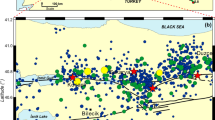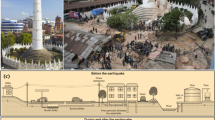Abstract
This study presents a soil-response analysis of Isparta basin, is situated in the one of most important tectonic areas, using surface wave (ReMi™) and borehole data at 24 points. In the analysis, the nonlinear site response analysis approach was carried out using the DeepSoil software. The study area was characterized by C and D soil class according to NEHRP (National Earthquake Hazards Reduction Program) and TBEC-2018 (Turkish Building Earthquake Code-2018) soil classification criteria. For the modelling, the strong ground motion recordings of 6.9 Mw Irpinia and 6.4 Mw Dinar were used and the largest peak ground acceleration (PGA) and spectral acceleration (SA) maps of the study area were created. The Bdr-1914 model was made using Irpinia record, PGA values in the study area were determined in the range of 0.28–0.41 g and SA in the range of 0.77–1.82 g. In the Dnr-1995 model, the PGA values in the basin were found to be between 0.05–0.1 g and SA was within the range of 0.21–0.48 g. It was observed that the spectral accelerations on the surface, which significantly increased the effects of strong ground motion, particularly for Mw 6.9, near the city center and the Çünür area where new settlement areas were dense. The results indicate that ground specific design is required for construction in these areas, which are above the risk threshold in acceleration design spectra. At the same time, these results show the site response studies have critical importance and may make a significant contribution to the design of safe structures in the alluvial basins.












Similar content being viewed by others
References
Akbulut A (1980) Eğirdir Gölü güneyinde Çandır (Sütçüler-Isparta) yöresindeki Batı Torosların jeolojisi. Geol Bull Turk 23(1):1–9 (In Turkish)
Ansal AM, Iyisan R, Gullu H (2001) Microtremor measurements for the microzonation of Dinar. Pure Appl Geophys 158:2525–2541
Arslan H, Siyahi B (2006) A comparative study on linear and nonlinear site response analysis. Environ Geol 50(8):1193–1200
Assimaki D, Kausel E, Whittle A (2000) Model for dynamic shear modulus and dam** for granular soils. J Geotech Geoenviron Eng 126(10):859–869
Basu D, Dey A (2016) Comparative 1D ground response analysis of homogeneous sandy stratum using linear, equivalent linear and nonlinear masing approaches. In: Geotechnics for Infrastructure Development. West Bengal, India: Indian Geotechnical Society
Basu D, Boga M, Dey A (2019) A time-domain nonlinear effective-stress non-masing approach of ground response analysis of Guwahati city, India. Earthq Eng Eng Vib 18(1):61–75
Blumenthal MM (1963) Le systeme structural du Taurus sud Anatolies, in: Livre a Memoire de Professor P. Fallot. Mem Soc Geol Fr 1(2):611–662
Bolisetti C, Whittaker AS, Mason HB, Almufti I, Willford M (2014) Equivalent linear and nonlinear site response analysis for design and risk assessment of safety-related nuclear structures. Nucl Eng Des 275:107–121
Borcherdt RD (1994) Estimates of site-dependent response spectra for design (methodology and justification). Earthq Spectra 10:617–617
Christenson GE (1994) Ground shaking in Utah (Public Information Series/Utah Geological Survey). Utah Geol Surv 29:1–4
Darendeli MB (2001) Development of a new family of normalized modulus reduction and material dam** curves. Ph.D., Civil Engineering, University of Texas at Austin
Gautam D, Forte G, Rodrigues H (2016) Site effects and associated structural damage analysis in Kathmandu Valley, Nepal. Earthq Struct 10(5):1013–1032
Görmüş M, Özkul M (1995) Gönen-Atabey (Isparta) ve Ağlasun (Burdur) Arasındaki Bölgenin Stratigrafisi. Süleyman Demirel Univ J Nat Appl Sci 1:43–64 (In Turkish)
Goto H, Sawada S, Morikawa H, Kiku H, Ozalaybey S (2005) Modeling of 3D subsurface structure and numerical simulation of strong ground motion in the Adapazari basin during the 1999 Kocaeli earthquake, Turkey. Bull Seismol Soc Am 95(6):2197–2215
Gutnic M, Poisson A (1970) Un Dispositif Remarkuable des Chaines Tauriques dans le Sud de la Courbure d’Isparta (Turquie meridion bale). Comptes Rendus Academie des Sciences Paris 270:672–675
Hasal ME, Iyisan R (2014) A numerical study on comparison of 1D and 2D seismic responses of a basin in Turkey. Am J Civil Eng 2(5):123–133
Hashash YM, Park D (2001) Non-linear one-dimensional seismic ground motion propagation in the Mississippi embayment. Eng Geol 62(1–3):185–206
Hashash YM, Park D (2002) Viscous dam** formulation and high frequency motion propagation in non-linear site response analysis. Soil Dyn Earthq Eng 22(7):611–624
Hashash YM, Phillips C, Groholski DR (2010) Recent advances in non-linear site response analysis. In: Proceedings of the fifth international conference on recent advances in geotechnical earthquake engineering and soil dynamics
Hashash YM, Dashti S, Romero MI, Ghayoomi M, Musgrove M (2015) Evaluation of 1-D seismic site response modeling of sand using centrifuge experiments. Soil Dyn Earthq Eng 78:19–31
Hashash YMA, Musgrove MI, Harmon JA, Ilhan O, Groholski DR, Phillips CA, Park D (2017) "DEEPSOIL 7.0, User Manual" Urbana, IL, Board of Trustees of University of Illinois at Urbana-Champaign
Hosseini SMMM, Pajouh MA (2012) Comparative study on the equivalent linear and the fully nonlinear site response analysis approaches. Arab J Geosci 5(4):587–597
Işık NS (2010) Assessment of the site amplifications and predominant site periods for Saruhanlı, in an earthquake-prone region of Turkey. Bull Eng Geol Environ 69(2):309–319
Kaklamanos J, Baise LG, Thompson EM, Dorfmann L (2015) Comparison of 1D linear, equivalent-linear, and nonlinear site response models at six KiK-net validation sites. Soil Dyn Earthq Eng 69:207–219
Kanlı AI, Tildy P, Prónay Z, Pınar A, Hermann L (2006) Vs30 map** and soil classification for seismic site effect evaluation in Dinar region, SW Turkey. Geophys J Int 165(1):223–235
Karaman ME, Meriç E, Tansel İ (1988) Çünür (Isparta) Dolaylarında Kretase-Tersiyer Geçişi. Akdeniz Univ J Isparta Eng Fac 4:80–100 ((In Turkish))
Khanbabazadeh H, Iyisan R, Ansal A, Hasal ME (2016) 2D non-linear seismic response of the Dinar basin, TURKEY. Soil Dyn Earthq Eng 89:5–11
Koçyiğit A, Özacar AA (2003) Extensional neotectonic regime through the NE edge of the Outer Isparta Angle, SW Turkey: new field and seismic data. Turk J Earth Sci 12(1):67–90
Kondner RL, Zelasko JS (1963) Hyperbolic stress-strain formulation of sands. Second pan American conference on soil mechanics and foundation engineering Sao Paulo, vol 1, Brazil, pp 289–324
Kramer SL (1996) Geotechnical earthquake engineering. Prentice–Hall international series in civil engineering and engineering mechanics. Prentice-Hall, New Jersey, pp 1–273
Kumar SS, Krishna AM, Dey A (2014) Nonlinear site-specific ground response analysis: case study of Amingaon, Guwahati. In: 15th symposium on earthquake engineering, IIT Roorke
Kwok AO, Stewart JP, Hashash YM, Matasovic N, Pyke R, Wang Z, Yang Z (2007) Use of exact solutions of wave propagation problems to guide implementation of nonlinear seismic ground response analysis procedures. J Geotech Geoenviron Eng 133(11):1385–1398
Louie JN (2001) Faster, better: shear-wave velocity to 100 meters depth from refraction microtremor arrays. Bull Seismol Soc Am 91(2):347–364
Louie JN, Pancha A, Pullammanappallil S (2017) Applications of refraction microtremor done right, and pitfalls of microtremor arrays done wrong. In: 16th World conference on earthquake engineering, Santiago Chile, Paper No: 4947
Matasovic N (1993) Seismic response of composite horizontally-layered soil deposits. Ph.D. Thesis, University of California, Los Angeles
McKenzie D (1972) Active tectonics of the Mediterranean region. Geophys J Int 30(2):109–185
Pancha A, Pullammanappallil S (2012) Determination of 3D-velocity structure across the deepest portion of the Reno area basin. US Geological Survey (External Grant Award No. G12AP20026, 54 pp). http://earthquake.usgs.gov/research/external/reports/G12AP20026
Pancha A, Pullammanappallil S, Louie JN, Cashman PH, Trexler JH (2017) Determination of 3D basin shear-wave velocity structure using ambient noise in an urban environment: a case study from reno, NevadaDetermination of 3D basin shear-wave velocity structure using ambient noise in an urban environment. Bull Seismol Soc Am 107(6):3004–3022
Park D, Hashash YM (2008) Rate-dependent soil behavior in seismic site response analysis. Can Geotech J 45(4):454–469
Phanikanth VS, Choudhury D, Reddy GR (2011) Equivalent-linear seismic ground response analysis of some typical sites in Mumbai. Geotech Geol Eng 29(6):1109
Phillips C, Hashash YM (2009) Dam** formulation for nonlinear 1D site response analyses. Soil Dyn Earthq Eng 29(7):1143–1158
Pullammanappallil S, Honjas B, Louie JN, Siemens JA, Miura H (2003) Comparative Study of the Refraction Microtremors Method: Using Seismic Noise and Standard P-Wave Refraction Equipment for Deriving 1D Shear-Wave Profiles. In: 6th SEGJ international symposium, Tokyo, pp 192–197
Rayhani MHT, El Naggar MH, Tabatabaei SH (2008) Nonlinear analysis of local site effects on seismic ground response in the Bam earthquake. Geotech Geol Eng 26(1):91–100
Régnier J, Bonilla LF, Bard PY, Bertrand E et al (2016) International benchmark on numerical simulations for 1D, nonlinear site response (PRENOLIN): verification phase based on canonical cases. Bull Seismol Soc Am 106(5):2112–2135
Régnier J, Bonilla LF, Bard PY, Bertrand E et al (2018) PRENOLIN: international benchmark on 1D nonlinear site-response analysis—validation phase ExercisePRENOLIN: international benchmark on 1D nonlinear site-response analysis-validation phase exercise. Bull Seismol Soc Am 108(2):876–900
Şafak E (2001) Local site effects and dynamic soil behavior. Soil Dyn Earthq Eng 21(5):453–458
Sagular EK, Görmüş M (2006) New stratigraphical results and significance of reworking based on nannofossil, foraminiferal and sedimentological records in the Lower Tertiary sequence from the northern Isparta Angle, Eastern Mediterranean. J Asian Earth Sci 27(1):78–98
Sana H, Nath SK, Gujral KS (2019) Site response analysis of the Kashmir valley during the 8 October 2005 Kashmir earthquake (M w 7.6) using a geotechnical dataset. Bull Eng Geol Environ 78(4):2551–2563
Sana H (2018) Seismic microzonation of Srinagar city, Jammu and Kashmir. Soil Dyn Earthquake Eng 115:578–588
Şengör AM, Yılmaz Y (1981) Tethyan evolution of Turkey: aplate tectonic approach. Tectonophysics 75:181–241
Silahtar A, Kanbur MZ, Beyhan G (2020) Investigation of a sedimentary basin by using gravity and seismic reflection data in the Isparta basin, Southwestern Turkey. Bull Eng Geol Environ 79:3971–3988
Sönmezer YB, Celiker M, Bas S (2019) An investigation on the evaluation of dynamic soil characteristics of the Elazig City through the 1-D equivalent linear site-response analysis. Bull Eng Geol Environ 78(7):4689–4712
Vucetic M, Dobry R (1991) Effect of soil plasticity on cyclic response. J Geotech Eng 117(1):89–107
Yoshida N (1994) Applicability of conventional computer code SHAKE to nonlinear problem. In: Proceedings of symposium on amplification of ground shaking in soft ground
Yoshida N, Iai S (1998) Nonlinear site response analysis and its evaluation and prediction. In: 2nd international symposium on the effect of surface geology on seismic motion, Yokosuka, Japan, pp 71–90
Author information
Authors and Affiliations
Corresponding author
Additional information
Publisher's Note
Springer Nature remains neutral with regard to jurisdictional claims in published maps and institutional affiliations.
Rights and permissions
About this article
Cite this article
Silahtar, A., Kanbur, M.Z. 1D nonlinear site response analysis of the Isparta Basin (Southwestern Turkey) with surface wave (ReMi) and borehole data. Environ Earth Sci 80, 268 (2021). https://doi.org/10.1007/s12665-021-09551-4
Received:
Accepted:
Published:
DOI: https://doi.org/10.1007/s12665-021-09551-4





